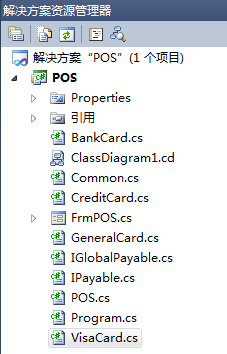POS模拟器
1.实训目的
本节通过模拟各种银行卡在POS机上消费的操作,来了解各种银行卡消费的特点,掌握面向对象程序的类、继承、接口的综合应用,掌握C# Windows编程中简单窗体控件的使用及事件的编程。
2.实训内容
(1) 创建Windows应用程序,将启动窗体命名为FrmPOS。
(2) 窗体设计:在窗体上添加1个Button控件、3个Label控件、2个RadioButton控件、2个ComboBox控件以及l个NumericUpDown控件。其中设置ComboBox的DropDownStyle属性值为DropDownList。控件具体的位置如图14.3所示。

图14.3 POS模拟器窗口设计
(3) 在应用程序中添加相应的类和接口。程序文档结构如图14.4所示,其类图如14.5所示。

图14.4 程序文档结构
图14.5 应用程序类图
(4) 选择不同卡种,在不同地区的POS机上消费演示,其运行结果如图14.6所示。

图14.6 消费运行结果图
3.程序代码
(1) 普通支付接口代码IPayable.cs
using System;
using System.Collections.Generic;
using System.Linq;
using System.Text;
namespace POS
{
//POS机支付接口
interface IPayable
{
void Pay(decimal money, POS pos);
}
}
(2) 国际支付接口代码IGlobalPayable.cs
using System;
using System.Collections.Generic;
using System.Linq;
using System.Text;
namespace POS
{
//支持POS机上国际支付
interface IGlobalPayable
{
void Pay(decimal money, Common.Currency currency, POS pos);
}
}
(3) 公共类代码Common.cs
using System;
using System.Collections.Generic;
using System.Linq;
using System.Text;
namespace POS
{
class Common
{
public enum Currency
{
人民币, 美元, 英镑, 欧元
}
}
}
(4) 普通银行卡类代码BankCard.cs
using System;
using System.Collections.Generic;
using System.Linq;
using System.Text;
namespace POS
{
//普通银行卡,没有支付功能,作为其他卡的基类
class BankCard
{
protected string id, region;
protected decimal balance = 0;
public decimal Balance
{
get { return balance; }
}
public BankCard(string id, string region)
{
this.id = id;
this.region = region;
this.balance=balance;
}
}
}
(5) 银联卡类代码GeneralCard.cs
using System;
using System.Collections.Generic;
using System.Linq;
using System.Text;
namespace POS
{
//银联卡
class GeneralCard : BankCard, IPayable
{
public GeneralCard(string id, string region, decimal balance)
: base(id, region,balance)
{
}
//银联卡具有支付功能,但必修保证卡上有余额
//银联卡如果跨地区支付需要收1%的手续费
public void Pay(decimal money, POS pos)
{
decimal cost = 0;
if (this.region != pos.Region)
cost = money * 0.01M;
if (balance >= money + cost)
balance -= (money + cost);
else
throw new InvalidOperationException("余额不足");
}
public override string ToString()
{
return string.Format("银联卡{0}", id);
}
}
}
(6) 信用卡类代码CreditCard.cs
using System;
using System.Collections.Generic;
using System.Linq;
using System.Text;
namespace POS
{
//信用卡
class CreditCard : BankCard, IPayable
{
private decimal credit;
public CreditCard(string id, string region,decimal balance, decimal credit)
: base(id, region,balance)
{
this.credit = credit;
}
//信用卡可以透支支付,但不能超出其信用额度
public void Pay(decimal money, POS pos)
{
if (money <= credit + balance)
balance -= money;
else
throw new InvalidOperationException("超出额度");
}
public override string ToString()
{
return string.Format("信用卡{0}", id);
}
}
}
(7) Visa卡类代码VisaCard.cs
using System;
using System.Collections.Generic;
using System.Linq;
using System.Text;
namespace POS
{
//国际信用卡Visa
class VisaCard: CreditCard, IGlobalPayable
{
public VisaCard(string id, string region,decimal balance, decimal credit)
: base(id, region, balance,credit)
{ }
//Visa卡支付时,支持国际货币支付,可以透支支付
public void Pay(decimal money, Common.Currency currency, POS pos)
{
decimal rate = 1;
if (currency == Common.Currency.美元)
rate = 7;
else if (currency == Common.Currency.英镑)
rate = 13;
else if (currency == Common.Currency.欧元)
rate = 10;
base.Pay(rate * money, pos);
}
public override string ToString()
{
return string.Format("Visa卡{0}", id);
}
}
}
(8) POS机类代码POS.cs
using System;
using System.Collections.Generic;
using System.Linq;
using System.Text;
namespace POS
{
class POS
{
private string region;
public string Region
{
get { return region; }
}
public POS(string region)
{
this.region = region;
}
}
}
(9) FrmPOS窗体后台代码FrmPOS.cs
using System;
using System.Collections.Generic;
using System.ComponentModel;
using System.Data;
using System.Drawing;
using System.Linq;
using System.Text;
using System.Windows.Forms;
namespace POS
{
public partial class FrmPOS : Form
{
BankCard[] cards;
POS pos1, pos2;
public FrmPOS()
{
cards = new BankCard[4];
cards[0] = new GeneralCard("g_bj_001", "Beijing", 1000);
cards[1] = new GeneralCard("g_sh_002", "Shanghai", 1000);
cards[2] = new CreditCard("c_bj_001", "Beijing", 1000);
cards[3] = new VisaCard("v_sh_001", "Shanghai", 1000);
pos1 = new POS("Beijing");
pos2 = new POS("Shanghai");
InitializeComponent();
}
private void Form1_Load(object sender, EventArgs e)
{
foreach (BankCard card in cards)
//将银行卡添加到下拉菜单
cmbCard.Items.Add(card);
for (int i = 0; i < 4; i++)
//将枚举中的货币类型添加到下拉菜单
cmbCurrency.Items.Add((Common.Currency)i);
cmbCard.SelectedIndex = cmbCurrency.SelectedIndex = 0;
}
//付款按钮事件
private void button1_Click(object sender, EventArgs e)
{
//确定支付的POS机
POS pos = radioButton1.Checked ? pos1 : pos2;
BankCard card = (BankCard)cmbCard.SelectedItem;
//获取选择支付的货币种类
Common.Currency cur = (Common.Currency)cmbCurrency.SelectedIndex;
try
{
if (cur == Common.Currency.人民币)
((IPayable)card).Pay(nudMoney.Value, pos);
else
((IGlobalPayable)card).Pay(nudMoney.Value, cur, pos);
MessageBox.Show("消费成功,余额" + card.Balance);
}
catch (InvalidCastException)
{
MessageBox.Show("该卡不支持此项消费");
}
catch (InvalidOperationException ex)
{
MessageBox.Show(ex.Message);
}
catch (Exception exp)
{
MessageBox.Show("消费失败: " + exp.Message);
}
}
}
}
4.实训总结
本节的上机实训,是一个面向对象程序设计中类、继承、接口知识以及C# Windows编程的一个综合应用。通过本实训,更深刻体会类、继承、接口在编程中应用。运用C#面向对象编程实现基本功能;运用和windows UI设计(Windows编程)设计POS机的人机交互界面。使用户能够方便的对Windows窗口的界面控件进行选择和操作,实现对程序中数据的输入和显示,通过按钮的事件驱动完成指定的操作来控制程序的运行。